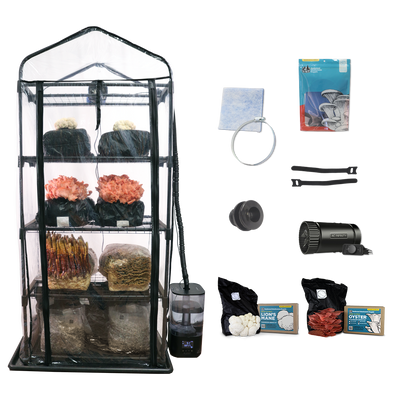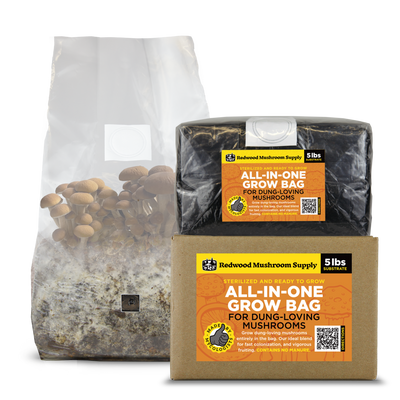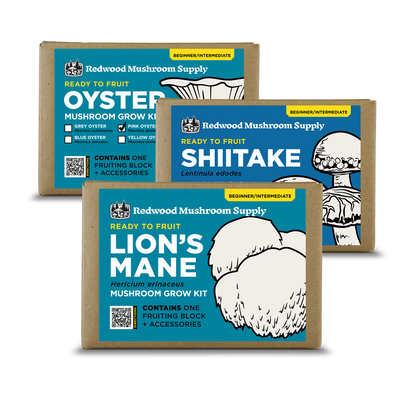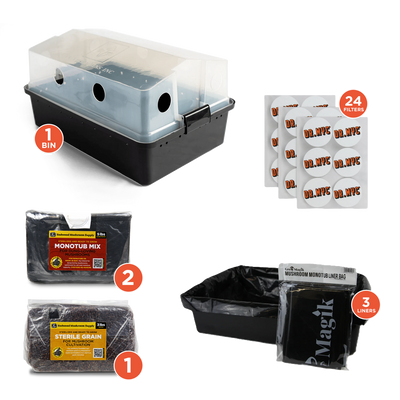Lighting is an important factor to consider in the mushroom cultivation process. This is especially true during fruiting, when mushrooms depend on light to grow and develop properly. Indeed, without adequate lighting growers may encounter challenges in their production and suffer from lower yields. In this article we’ll cover everything you need to know about managing light in mushroom cultivation to get optimal harvests.
Since lights are most important during the fruiting stage of mushroom cultivation, we also recommend you check out our in-depth guide about fruiting mushrooms. There we discuss what you should consider in terms of temperature, humidity, and fresh air exchange in addition to lighting. If you want to learn more about mushroom cultivation in general, make sure to check out our introductory series on mushroom cultivation.
The Role of Light in Mushroom Cultivation

While mushrooms can’t exactly see their surroundings, they do have a limited capacity to sense light in their environment. Notably, mushrooms can respond to different colors of light and even detect its intensity. They achieve this through specialized photo-receptive proteins, which can modify gene expression or alter metabolic functions based on the presence or absence of light. This is particularly significant during fruiting, where lighting—or the lack thereof—can influence the development of mushrooms as well as the quantity and types of compounds they produce.
Why Is Lighting Important For Mushroom Growth?

-
Stimulates Pinning: Light can trigger mycelium to begin producing fruiting bodies. This can be useful when transfering blocks from an incubation space into a fruiting room/chamber to facilitate quick and vigorous fruiting. Likewise, excessive lighting during incubation could stimulate early pinning before a block is fully colonized.
-
Morphological Development: Light can influence the size and shape of a mushroom during development. Low light conditions can cause mushrooms to develop thin elongated stems and small caps. Likewise, higher light conditions can lead to shorter stems and larger diameter caps. While most species require some light to develop as desired, Enoki (Flammulina velutipesi) utilize the absence of light to achieve a unique and valued growth structure/color.
-
Color: Many mushrooms require light to produce pigments on their cap surface. You can think of this a bit like the way people tan when they are exposed to sunlight. Mushrooms growing with insufficient light are often pale and lack the characteristic colors of the variety/species.
-
Nutritional and Medicinal Quality: The presence of light can influence the quantity of nutritional and therapeutic compounds found in the mushrooms. For example, one study showed that light positively influenced the quantity of riboflavin and thiamin in oyster mushrooms. Other studies have shown that light will influence the bioactive compounds found in Reishi and Cordyceps mushrooms. UV light is also well known to improve the Vitamin D2 content of edible mushrooms.
- Yield: Numerous studies (1, 2, 3, 4) and anecdotal evidence shows that providing proper lighting improves overall yield.
How To Manage Light In Your Cultivation Setup

Compared to temperature, humidity, and fresh air exchange, lighting is one of the easier environmental conditions to control during mushroom cultivation. To manage light, growers can utilize either natural or artificial lighting.
-
Natural Lighting: If your growing space has windows or some access to the ambient sunlight, this is usually enough to meet the needs of your grow. This said, growers should avoid direct sunlight, and only provide indirect or diffused light to their grow. Generally speaking about 6-8 hours of indirect sunlight is plenty for stimulating healthy growth.
- Artificial Lighting: Mushrooms are not too picky about their light source, and typically do great with any form of artificial light. These can be traditional light bulbs or LEDs of any type. We’ll further discuss how to set up lighting if you are growing in an enclosed space without access to natural light.
Choosing The Right Light

If you are cultivating in a grow tent or grow room with no access to natural lighting, you will need to utilize artificial lights to meet the lighting needs of your mushroom. While almost any type of light can do the job, there are certain lighting options which are superior to others. Lights like the AC Infinity IONBEAM S11 LED Light Bars make an excellent option which we can highly recommend based on our experience.
-
Adjustability: Being able to adjust the light intensity allows for high versatility and ease of use. This allows you to mount the lighting where ever is most convenient and then adjust the light intensity from there.
-
Efficiency: LED lights are highly recommended as they are energy efficient and do not release additional heat into your grow room. They also last much longer than other types of lighting.
-
Easy-To-Mount: Most growers like utilizing light bars or strips as they are easy to mount and can provide even coverage in the growing area.
-
Programable: Some lights can be set on an automatic schedule that removes the need for manual control. If your lights do not have this built in, it is possible to utilize an external timer which will meet the same needs.
-
Full Spectrum: Full spectrum lights ensure that you get all the diverse wavelengths of visible light. This is important because certain wavelengths, such as blue light, are more important for healthy mushroom growth.
-
Durability: It’s an excellent idea to get a light which is resistant to moisture and dust. Since these are positioned in a fruiting room, they will be subject to high humidity levels and potentially a lot of spores which could impede the proper functioning of the light. Look for a light that is IP65-rated, meaning it has been tested to withstand dust and high moisture levels.
Setting Up Your Lights
Mushrooms have a wide range of tolerance when it comes to lighting, making the setup rather easy and not requiring much precision on the part of the grower.
-
Mushrooms prefer a light intensity between 100 to 300 LUX. LUX is a unit of measurement for light intensity which your probably familiar with if you’ve ever bought a headlamp or bike light. Since the LUX decreases the farther you get from the light source, it is important to accurately asses your lights intensity and distance. There are many phone applications which can measure LUX that can be useful when assessing intensity.
-
You will want to provide about 12 hours of light per day. This can be easiest with a timer that will ensure consistent conditions that make your mushrooms happy. Also consider that mushrooms tend to benefit from the light/dark cycle, so try to provide atleast another 12 hours of darkness.
-
Focus on achieving even light distribution and appropriate intensity. You will want to position your lights to avoid shadows and ensure all parts of the growing area are receiving adequate light.
Conclusion

Lighting is a vital yet often underestimated factor in mushroom cultivation. Proper lighting not only enhances mushroom quality and yield but also supports their nutritional and medicinal potential. By implementing appropriate lighting solutions, growers can create optimal conditions for fruiting. If you have any questions about lighting feel free to reach out to our team of experts who could offer guidance on this topic.
Cheers and happy growing!
FAQ - Lighting for Mushroom Cultivation
Do mushrooms need light to grow?
Most mushrooms require light during the fruiting stage to develop properly. Tey use light as a signal for growth, shape, and color development.
Why is lighting important for mushroom growth?
Lighting plays a crucial role in mushroom cultivation, especially during the fruiting stage. It stimulates pinning, influences morphological development, enhances pigmentation, improves nutritional and medicinal quality, and ultimately increases yield.
What type of light is best for growing mushrooms?
Natural or artificial light can work. If using artificial light, LEDs are a great choice due to their efficiency, adjustability, and longevity. Consider a light that is IP65-rated for resistance to moisture and dust.
How much light do mushrooms need?
A light intensity of 100-300 LUX for about 12 hours per day is ideal. They enjoy a dark cycle of 8-12 hours aswell.
Can I use sunlight for my mushrooms?
Yes, indirect sunlight is great for mushrooms. Aim for 6-8 hours of indirect sunlight per day. Avoid direct sunlight.
What color light is best for mushrooms?
Blue light (within the full spectrum) is particularly beneficial for mushroom development, but a full-spectrum light is reccomended.
Can mushrooms grow in complete darkness?
Yes, but they will display a different growth pattern which is not usually desired. The exception is with Enoki (Flammulina velutipes) which is purposefully cultivated in the dark.
Does UV light improve mushroom quality?
Yes, UV light exposure can enhance the Vitamin D2 content in mushrooms, making them more nutritionally valuable.




